What are Non-Fullerene Acceptors?

Non-fullerene acceptors (NFAs) are organic molecules that, like fullerenes, act as electron acceptors in organic solar cells and other organic electronic devices. However, unlike fullerenes, NFAs lack the hollow cage structure and offer greater flexibility in molecular design, allowing for tunable electronic and optical properties. The most frequently used NFAs are highly conjugated structures based on:
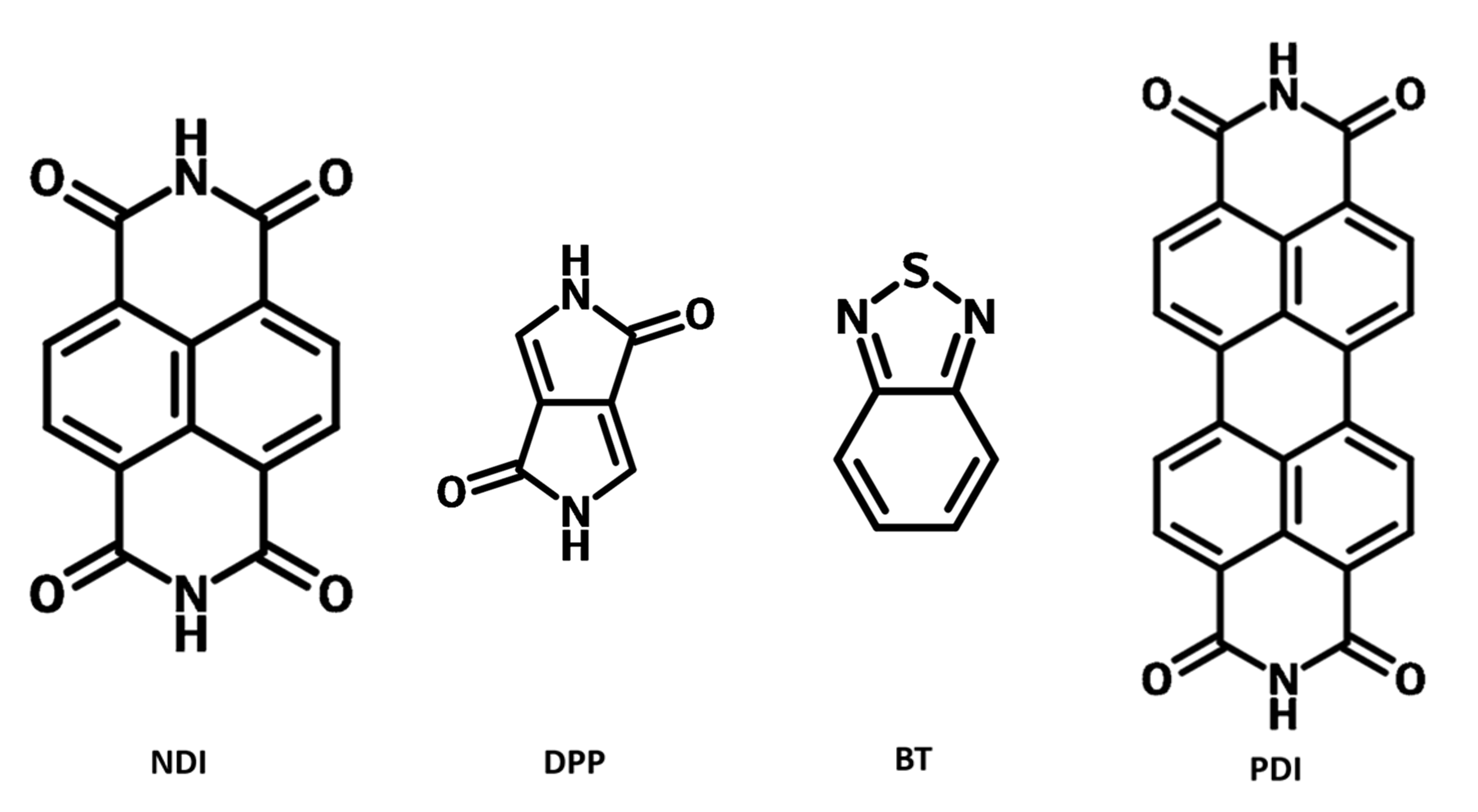
- Naphthalene diimide (NDI)
- Diketopyrrolopyrrole (DPP)
- Benzothiadiazole (BT)
- Perylene diimide (PDI)
- Indacenodithienothiophene (IDTT)
NFAs are typically based on highly conjugated backbones to allow for fine-tuning of their structural, light absorption, electronic properties. One of the breakthroughs in NFA design was the development of fused-ring electron acceptors (FREAs), i.e. ITIC, marking the start of a new generation of non-fullerene acceptors for organic photovoltaics (OPVs).
Since then, NFAs have emerged as a game-changing material in the field of organic photovoltaics (OPVs) over the last decade. Following the successful development of ITIC, Y6, another fused-ring electron acceptor, has been one of the most studied NFAs in terms of device efficiency. NFAs have now become the focus of bulk-heterojunction solar cell research due to their superior performance, tunability, and stability compared to fullerene based molecules.
Key Features of Non-Fullerene Acceptors
Non-fullerene acceptors such as ITIC and Y6 offer several advantages over traditional fullerene acceptors (such as C60) used in organic solar cells. Some of the key features of non-fullerene acceptors include:
Non-Fullerene Acceptors

Why are NFAs important
Non-fullerene acceptors (NFAs) represent the next generation of organic solar cell materials, enabling power conversion efficiencies that are now competitive with other solar technologies. Historically, fullerenes were the dominant choice for the electron acceptor component in bulk heterojunction organic solar cells. While fullerenes helped establish the foundation for organic photovoltaics (OPVs), their limitations have become apparent as the field seeks to push device efficiencies further.
One major drawback of fullerene-based acceptors is their limited tunability in terms of both electronic and optical properties. This restricts the extent to which the energy levels can be optimized for better charge transfer, leading to performance bottlenecks. Fullerenes exhibit very weak absorption in the visible spectrum, meaning they contribute minimally to light absorption. Donor materials are therefore solely responsible for photon capture. In cases where the polymer donor material is deficient in absorption at certain wavelengths, fullerenes cannot compensate. This further limits overall device efficiency.
NFAs address these limitations by offering greater flexibility in molecular design, enabling their electronic properties to be fine-tuned and their optical absorption to be extended into the visible and even near-infrared regions. This results in more efficient charge generation, reduced energy loss, and better overall performance in organic solar cells. On top of this, OPVs based on NFAs have shown remarkable operation stability with the help of protective buffer layers.
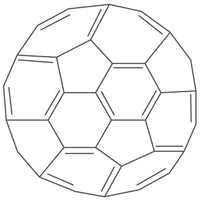
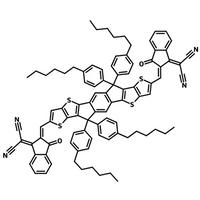
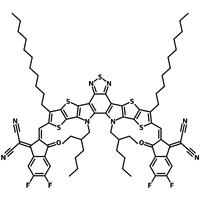
Structure and Properties of Non-Fullerene Acceptors
Non-fullerene acceptors (NFAs) are organic molecules designed with a conjugated backbone and functional groups that allow for tunable electronic and optical properties. The molecular structure of NFAs is crucial in determining their performance in organic solar cells and other organic electronic devices. NFAs generally fall into two categories:
- Small-Molecule Acceptors (SMAs)
- Polymeric Acceptors
The structure of non-fullerene acceptors (NFAs) is key to their performance in organic solar cells. By tuning components like the conjugated backbone, electron-donating and withdrawing units, and side chains, NFAs can optimize energy levels, charge transport, and morphology. The next section explores how these structural features impact the molecular properties of NFAs.
Structural Features and Their Effects
Conjugated Backbone
- Ensures efficient electron transport and forces a planar structure, which promotes strong intermolecular interactions (e.g., π–π stacking).
- Enhances charge mobility and helps in creating well-ordered molecular packing.
Electron-Donating and Electron-Withdrawing Units
- These chemical groups define the highest occupied molecular orbital (HOMO) and lowest unoccupied molecular orbital (LUMO), controlling the bandgap and influencing charge separation.
- Electron-deficient units improve electron affinity and molecular packing, while electron-rich units enhance charge carrier mobility.
Side Chains
- Attached to NFAs to control solubility and processability.
- Prevent excessive aggregation, ensuring optimal phase separation and improved device morphology in organic solar cells.
Heteroatoms, Bridging Atoms and π-Spacers
-
Heteroatoms such as halogens, nitrogen (N), sulfur (S), and oxygen (O) are frequently integrated into NFA structures to fine-tune their electronic properties:
- Electron-withdrawing atoms (eg. halogens, N) and groups (eg. cyano - CN) increase electron affinity and lower the LUMO level, which enhances electron transport. They also aid in optimizing molecular packing through its ability to form hydrogen bonds and dipole interactions.
- Sulfur atoms can increase charge mobility due to their larger atomic size, which promotes effective π–π stacking and stronger intermolecular interactions.
- Heteroatoms in bridging positions provide electron-donating properties and enhance charge transport.
- π-spacers influence conjugation length, affecting the material's bandgap and optical absorption.
Types of Non-Fullerene Acceptors
There are many different types of non-fullerene acceptors based on the different conjugated core molecules mentioned above. NFA properties can be fine tuned via different structural features to alter the HOMO and LUMO energy levels, processibility and molecular packing.
It is important to choose the correct NFA for your desired application to ensure optimal performance.
Browse Non-Fullerene Acceptors
Key Applications of Non-Fullerene Acceptors
The key applications of non-fullerene acceptors (NFAs) are in the field of organic electronics, particularly in organic solar cells. Their versatile properties make them useful in a range of devices, including:
- Organic Solar Cells: NFAs are used in standard bulk-heterojunction solar cells as well as tandem solar cells and other flexible photovoltaic devices.
- Organic Photodetectors: NFAs' broad optical absorption and tunable energy levels make them ideal for devices that detect light across a wide spectral range, including the visible and near-infrared (NIR) regions.
- Organic Field Effect Transistors (OFETs):NFAs' tunable electronic properties and high electron mobility contribute to efficient charge transport and switching.
- Organic Light Emitting Diodes (OLEDs): NFAs have potential in OLED technology due to their efficient charge-transport properties. They could play a role in improving electron injection or transport layers in OLEDs, enhancing display technologies and lighting.
The range of NFAs being developed is constantly expanding. Here are some examples of NFAs used in different devices and their resulting properties:
| NFA Core / Family | NFA | NFA Properties | Device Type | Device Property and Value |
|---|---|---|---|---|
| BT | L8-BO |
|
Organic Solar Cell | PCE of 20.1 % |
| DPP | DPPSe-4Cl |
|
Organic Photodetector |
Specific detectivity of >1012 Jones in the wavelength range 410-1030 nm Range of 300-1100 nm |
| NDI | BiNDI |
|
Thin film transistor | Electron mobility of 0.365 cm2 V−1 s−1 in ambient atmosphere |
| BT | TPACNBz |
|
Organic Light-Emitting Diode |
Maximum radiance of 10020 mW Sr−1 m−2 Maximum EQE of 6.57% Peak wavelength of 712 nm |
Challenges and Future of Non-Fullerene Acceptors
NFAs have had a significant impact on the OPV field and their development has led to a steady rise in PCEs. However, challenges remain, such as:
- Improving the device lifetime under real-world conditions
- Enhancing large-scale manufacturability
- Reducing the use of toxic solvents during processing
Most NFAs must be handled in a glove box, particularly during the fabrication of organic solar cells or other organic electronic devices. This is because many NFAs are sensitive to environmental factors such as oxygen and moisture, which can degrade their electronic properties, affect film formation, and reduce device performance. Ongoing research aims to address these challenges by further tuning molecular structures, exploring new fabrication methods, and integrating NFAs into various device architectures like tandem solar cells.
Non-fullerene acceptors represent a paradigm shift in OPV technology, offering enhanced performance, better stability, and greater design flexibility compared to their fullerene counterparts. As research continues, NFAs are poised to play a key role in the development of next-generation solar energy solutions.
Learn More
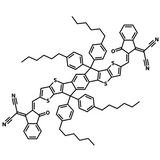 ITIC & Derivatives as OPV Acceptors
ITIC & Derivatives as OPV Acceptors
Of the significant efforts in research devoted to NFAs, the proposal of the fused-ring system ITIC in 2015 has generated the most success. In the initial paper proposing ITIC, a power conversion efficiency (PCE) of 6.80% was achieved in combination with a PTB7-TH donor.
Read more... What is a Photodetector?
What is a Photodetector?
A photodetector is a device that can detect light, or more specifically photons. They are classed as optoelectronic devices like photovoltaic devices. This is because they produce an electronic signal which is proportional to the incident optical input.
Read more...
References
- An Electron Acceptor Challenging Fullerenes for Efficient Polymer..., Lin, Y. et al., Advanced Materials (2015)
- Non-Fullerene Electron Acceptors for Use in Organic Solar..., Nielsen, C. B. et al., Accounts of Chemical Research (2015)
- New advances in non-fullerene acceptor based organic solar..., Zhan, C. et al., RSC aDv. (2015)
- Non-fullerene acceptor organic photovoltaics with intrinsic operational lifetimes..., Li, Y. et al., Nature Communications (2021)
- Recent progress in organic solar cells based on..., Luo, D., J. Mater. Chem. A (2022)
Contributors
Written by
Application Scientist
Diagrams by
Graphic Designer




